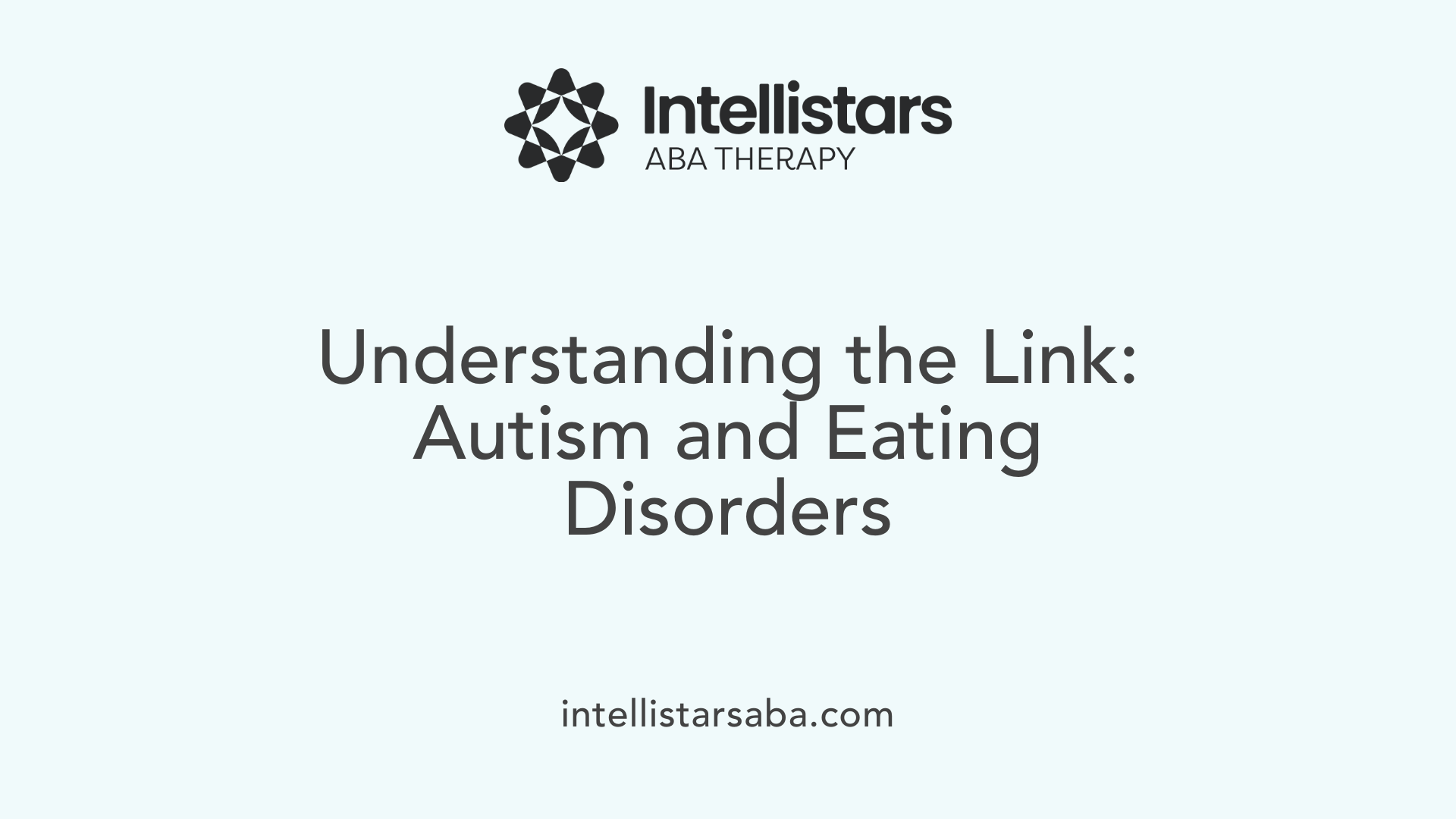Understanding the Overlap Between Autism and Eating Disorders
Eating disorders and autism spectrum disorder (ASD) frequently coexist, presenting intricate challenges for diagnosis, treatment, and recovery. This overlap influences clinical outcomes, requiring tailored approaches to therapy and care. In this article, we explore the association between these conditions, delve into the behavioral characteristics linking them, and discuss innovative therapeutic strategies, including Applied Behavior Analysis (ABA), for improving patient outcomes.
Link Between Autism and Eating Disorders: Prevalence and Clinical Challenges

What is the association between autism and feeding and eating disorders?
There is a clear and reliable association between autism spectrum disorder (ASD) and feeding and eating disorders. Research estimates that between 4% and 23% of individuals diagnosed with an eating disorder also meet criteria for autism. In adults with eating disorders, about 20–30% have an autism diagnosis, while in young people the figure ranges from 3% to 10%.
How common are autism traits in individuals with eating disorders?
Autism traits like sensory sensitivities, rigid routines, and difficulties in social and emotional understanding significantly overlap with eating disorder symptoms. For example, autistic individuals may show selective eating patterns due to texture sensitivities or strict food rituals that mirror restrictive eating behaviors seen in disorders such as anorexia nervosa (AN) or avoidant/restrictive food intake disorder (ARFID).
What are the clinical challenges when autism and eating disorders co-occur?
The co-occurrence of autism and eating disorders results in more complex clinical presentations and poorer treatment outcomes. Traditional treatments, including cognitive behavioral therapy (CBT) and other psychotherapies, often face challenges because autistic traits such as communication difficulties, emotional recognition problems, and insistence on routines interfere with standard approaches.
Patients with both ASD and eating disorders often experience longer and more severe illness courses. Sensory sensitivities and rigid behavioral patterns require therapy adaptations, such as simplified language, visual supports, involvement of family members, and gradual flexibility management rather than sudden behavioral changes.
Clinicians frequently report a lack of confidence and standardized protocols when treating individuals with this comorbidity, sometimes seeking guidance from more experienced colleagues. This variation in clinical practice underscores the need for specialized, individualized care approaches.
What behavioral and neurological traits contribute to the overlap?
Shared characteristics like inflexibility, repetitive behaviors, sensory processing difficulties, and intense focused interests are common in both autism and eating disorders. Neurologically, these traits can drive restrictive eating patterns, exacerbate anxiety around food, and increase ritualistic behaviors related to eating routines.
Moreover, autism's core symptoms—such as social communication challenges and need for sameness—can manifest as or worsen eating disorder behaviors, creating a complex interplay between the two conditions.
In summary, the convergence of autism and feeding and eating disorders is significant and clinically impactful. Understanding this overlap improves insight into the challenges faced and highlights the urgent need for tailored treatment strategies that accommodate the unique needs of individuals living with both conditions.
Shared Traits and Mechanisms Underlying Autism and Eating Disorders

What are the potential mechanisms underlying the link between autism and eating disorders?
There is a reliable and complex association between autism spectrum disorder (ASD) and feeding and eating disorders. This connection arises from several overlapping traits and potential causal mechanisms that intertwine the two conditions.
One major factor involves conceptual overlaps. Individuals with autism often experience sensory sensitivities and a need for strict routines, which can lead to selective or ritualistic eating patterns. These behaviors closely mirror symptoms found in eating disorders, such as restrictive eating and inflexibility around food choices.
Additionally, common autistic traits like repetitive behaviors and insistence on sameness may directly manifest as disordered eating habits, reinforcing restrictive diets and food avoidance. For example, sensory issues related to food texture or taste can provoke intense aversions, contributing to disorders like Avoidant/Restrictive Food Intake Disorder (ARFID).
Another important mechanism considers that autism may directly or indirectly cause feeding and eating disorders. In some cases, eating disorder symptoms, especially in females, might be a manifestation or expression of underlying autism that has gone undiagnosed or masked. Furthermore, transient autistic traits can occur during acute phases of an eating disorder, complicating diagnosis and treatment.
Shared underlying causes, including neurodevelopmental vulnerabilities such as rigidity in thinking and sensory processing challenges, provide a foundational explanation for the frequent comorbidity seen between these conditions. These shared traits increase the risk of disordered eating developing in autistic individuals.
Understanding these linked mechanisms is essential for informing tailored, effective behavioral therapies that address both autism and eating disorder symptoms simultaneously. Clinicians emphasize the importance of comprehensive and individualized approaches to treatment, considering these intersecting traits and causes.
Impact of Autism on Clinical Presentation and Treatment of Anorexia Nervosa

How does autism influence anorexia nervosa presentation and treatment?
Autism spectrum disorder (ASD) significantly affects the clinical presentation of anorexia nervosa (AN) by amplifying certain traits that complicate symptoms. Individuals with ASD often display heightened perfectionism, a strong desire for control, and increased rigidity in routines. These traits intensify anorexic behaviors, making symptoms more severe and leading to longer-lasting illness trajectories.
Sensory sensitivities common in autism play a pivotal role in shaping food intake patterns. Many autistic individuals experience intense sensory processing challenges, which can manifest as aversions to specific food textures or tastes. This can result in highly restrictive diets or selective eating, often worsening anorexia symptoms or complicating nutritional rehabilitation efforts.
Communication and emotional recognition difficulties inherent to ASD further complicate engagement in standard therapeutic approaches. Challenges in interpreting social cues and emotions can hinder the effectiveness of widely used psychotherapeutic methods such as cognitive behavioral therapy (CBT) and cognitive analytic therapy (CAT). These therapies typically rely on shared understanding and emotional insight, which may be impaired in autistic individuals, leading to less effective treatment outcomes.
To better support patients with co-occurring ASD and AN, treatment approaches require adaptation. Simplifying language, employing visual aids, involving family members, and respecting rigidity by managing flexibility gradually have been found helpful. There is also a recognized need for providers specialized in addressing both conditions simultaneously to achieve meaningful progress.
| Aspect | Influence of Autism on Anorexia Nervosa | Therapeutic Implications |
|---|---|---|
| ASD Traits | Heightened perfectionism, need for control, rigidity | Requires tailored behavioral interventions |
| Sensory Sensitivities | Selective eating based on food texture and taste | Nutritional plans must consider sensory preferences |
| Communication & Emotion | Difficulty recognizing and processing emotional and social cues | Adjustments in therapy methods (e.g., simplified CBT) |
Understanding these complexities is essential for developing comprehensive, individualized treatment plans that improve outcomes for individuals with co-occurring autism and anorexia nervosa.
Challenges Clinicians Face in Treating Co-Occurring ASD and Eating Disorders

What challenges do clinicians face in managing patients with both autism and eating disorders?
Many clinicians experience a lack of confidence and limited experience when treating patients with both autism spectrum disorder (ASD) and anorexia nervosa (AN). This difficulty is compounded by the absence of clear, standardized pathways for assessing or diagnosing ASD traits within patients suffering from eating disorders, leading to considerable variation and uncertainty in practice.
Clinicians frequently report the need to seek additional information or consult more experienced colleagues to handle these complex cases effectively. This reliance on peer collaboration highlights gaps in current training and resources regarding the co-management of ASD and eating disorders.
Further complicating treatment, traits of ASD such as communication difficulties, emotional regulation challenges, and rigidity pose unique obstacles in therapeutic approaches. These challenges make traditional psychotherapeutic methods like cognitive behavioral therapy (CBT) or cognitive analytic therapy (CAT) less straightforward, demanding adaptation and individualized strategies.
Overall, the lack of structured assessment frameworks and clinician expertise creates significant hurdles in delivering optimal care for patients experiencing the dual diagnosis of ASD and eating disorders, emphasizing the urgent need for more comprehensive training and standardized clinical guidelines.
Behavioral Therapy Approaches: The Role of Applied Behavior Analysis (ABA)
What is Applied Behavior Analysis (ABA) therapy?
ABA therapy is a scientifically grounded treatment approach that focuses on understanding and modifying behavior using learning principles, primarily positive reinforcement. It aims to develop skills like communication, social interaction, and daily living tasks while decreasing behaviors that interfere with functioning. Individualized programs are designed according to each person's needs and are typically delivered by credentialed professionals. ABA strategies include discrete trial training and pivotal response treatment, which help promote measurable and meaningful improvements in developmental outcomes.
What types of techniques are used in ABA therapy?
ABA incorporates a variety of strategies to support behavioral change. Common techniques include:
- Positive reinforcement: Rewarding desired behaviors to increase their occurrence.
- Discrete trial training: Structured teaching of skills in small, manageable steps.
- Modeling: Demonstrating behaviors for imitation.
- Prompting and fading: Providing cues that are gradually removed as skills improve.
- Behavior chaining: Linking individual behaviors into complex sequences.
- Extinction: Reducing unwanted behaviors by withholding reinforcement.
- Visual supports: Using diagrams or images to aid understanding.
Specialized methods like Pivotal Response Treatment (PRT) and the Early Start Denver Model (ESDM) further tailor interventions to meet unique challenges faced by individuals with autism.
How does ABA therapy benefit individuals with autism?
ABA therapy effectively teaches essential skills by reinforcing positive behaviors and helping reduce difficulties. For autistic individuals, it can improve communication, social skills, and independence through systematic, evidence-based methods. When applied consistently and over time, ABA promotes greater self-sufficiency and enhances social engagement. This approach is valuable especially when integrated into comprehensive, individualized care plans addressing the complex needs of autistic people, including those with co-occurring conditions such as eating disorders.
Providers of ABA Therapy and Their Roles in Autism Support
Who typically provides ABA therapy for autism?
ABA therapy for autism is delivered by trained professionals who specialize in behavior analysis. This team commonly includes Board Certified Behavior Analysts (BCBAs), assistant behavior analysts known as BCaBAs, and Registered Behavior Technicians (RBTs).
Roles of Board Certified Behavior Analysts (BCBAs), assistants, and therapists
Board Certified Behavior Analysts design and oversee individualized treatment plans tailored to the needs of each person with autism. They conduct assessments, develop therapy goals, and supervise the overall therapy process. Assistant behavior analysts (BCaBAs) often support BCBAs by implementing treatment plans under supervision, while Registered Behavior Technicians work directly with clients delivering daily therapy interventions.
Settings and coordination with families for effective therapy
ABA therapy can take place in various settings including the home, school, clinics, or community environments. Effective therapy involves close coordination with families to ensure that the skills learned during sessions generalize to everyday life. Family involvement helps maintain consistency, reinforce positive behaviors, and adapt interventions to the individual's evolving needs.
| Provider Role | Primary Responsibilities | Typical Settings |
|---|---|---|
| Board Certified Behavior Analyst (BCBA) | Designs and oversees treatment plans; supervises therapy | Clinic, home, school |
| Assistant Behavior Analyst (BCaBA) | Implements therapy under BCBA supervision | Clinics, schools, community |
| Registered Behavior Technician (RBT) | Delivers daily interventions directly to clients | Home, school, community |
This multi-level provider structure supports comprehensive and individualized ABA therapy, positively impacting autism support and development.
Tailoring Behavioral Therapies for Individuals with Autism and Eating Disorders
How can behavioral therapies be adapted for treating individuals with autism and eating disorders?
Behavioral therapies for people with co-occurring autism spectrum disorder (ASD) and eating disorders such as anorexia nervosa (AN) require a highly personalized approach. One-on-one interventions are often most effective, allowing treatment to address specific challenges related to autism traits, including sensory sensitivities, communication difficulties, and need for routine.
Need for personalized, one-on-one behavioral interventions
Personalized care focuses on the unique needs of each individual, recognizing that rigid thinking, sensory aversions, and inflexible eating patterns can exacerbate eating disorder symptoms. Individual therapies provide space to gradually introduce flexibility while respecting the person's routines and preferences.
Specific therapies beneficial for comorbidity like ERP and CRT
- Exposure and Response Prevention (ERP): ERP helps patients confront and manage feared foods and eating situations slowly and safely, which is especially useful for those with autism and avoidant restrictive food intake disorder (ARFID).
- Cognitive Remediation Therapy (CRT): CRT aims to improve cognitive flexibility and central coherence, enhancing everyday functioning and adaptability, which supports recovery from eating disorders complicated by neurodevelopmental conditions.
Adapting communication and sensory strategies
Treatments are adapted to suit communication styles typical of autism. This includes simplifying language, using clear visual aids, and involving family members to improve understanding and emotional recognition. Sensory sensitivities require modifications to dietary plans and therapeutic environments to avoid triggering discomfort. Maintaining consistent routines while introducing gradual change helps ease anxiety and fosters engagement.
Through these tailored approaches, behavioral therapies can become more accessible and effective for individuals with both autism and eating disorders, improving outcomes despite the complexity of their co-occurring conditions.
Sensory and Emotional Regulation: Crucial Considerations in Therapy
What role do sensory and emotional regulation play in autism and eating disorder treatment?
Individuals with autism often experience heightened sensory sensitivities that directly influence their eating behaviors. These sensory challenges can manifest as aversions to specific food textures, tastes, or smells, leading to selective or restrictive eating patterns commonly seen in disorders like ARFID (Avoidant/Restrictive Food Intake Disorder).
To address these challenges, therapy often incorporates sensory regulation techniques that aim to reduce overwhelming sensory input and support emotional stability during mealtime and treatment sessions. One widely recognized method is the use of the "3 E's"—Emotions, Environment, and Extras. This approach focuses on identifying and managing emotional responses, modifying surroundings to reduce sensory overload, and introducing additional supportive elements or tools to ease sensory discomfort.
Emotional regulation also plays a critical role in treatment outcomes. Many autistic individuals face difficulties with recognizing and expressing emotions, which complicates engagement with traditional psychotherapeutic methods such as cognitive behavioral therapy (CBT). Emotional dysregulation can hinder recovery by making it harder for patients to cope with anxiety, rigidity, or distress related to eating and body image.
Therefore, successful interventions are those that consider both sensory and emotional needs. Techniques might include adapting language to be clear and concrete, using visual supports, involving family members, and gradually increasing flexibility rather than enforcing abrupt behavioral changes. By embracing these tailored strategies, therapists can better support autistic individuals in overcoming eating disorder symptoms through more accessible and compassionate care.
In summary, sensory and emotional regulation are foundational components in managing co-occurring autism and eating disorders. Sensory sensitivities affect food acceptance, while emotional challenges influence the patient’s ability to engage with treatment. Employing targeted regulation strategies enhances therapeutic effectiveness and promotes sustained recovery.
Towards Better Outcomes: Need for Standardized Guidelines and Integrated Care

Current gaps in standardized treatment protocols
Despite the recognized association between autism spectrum disorder (ASD) and eating disorders, notably anorexia nervosa (AN), there are no clear or standardized pathways for assessment or diagnosis of ASD traits in patients with eating disorders. Treatment approaches largely depend on individual clinicians' experience and confidence, which varies widely. This inconsistency leads to variation in clinical practice and hinders optimal care delivery.
Importance of integrated, multidisciplinary approaches
Effective treatment of co-occurring autism and eating disorders requires an integrated, multidisciplinary approach that goes beyond traditional interventions. Combining behavioral therapy (such as cognitive behavioral therapy, exposure response prevention, and cognitive remediation therapy), nutritional counseling, and family involvement is essential to address the complex interaction of neurodevelopmental and eating disorder symptoms. Tailored care plans must consider communication difficulties, sensory sensitivities, and rigidity inherent to autism.
Recommendations for reasonable therapy adjustments to support autistic individuals
Adapting therapy techniques is crucial to support autistic individuals effectively. Reasonable adjustments include simplifying language, using visual aids, providing clear and consistent information, and maintaining routine settings to reduce anxiety. Involving family members and emphasizing gradual management of rigidity rather than attempting rapid behavioral changes help accommodate the patient's needs. Sensory regulation strategies (e.g., addressing emotions, environment, and extras) also enhance recovery outcomes.
Addressing the treatment needs of autism and eating disorder comorbidity
There is a pressing need for empirically tested and standardized guidelines specifically targeting the comorbidity of ASD and eating disorders. Such guidelines would enhance clinician confidence, reduce practice variability, and ensure that the unique challenges posed by co-occurring conditions—like difficulties with emotional recognition and communication—are addressed systematically. Tailored, integrated care models promote better clinical outcomes and foster long-term recovery for affected individuals.
Improving Care for Individuals with Autism and Eating Disorders
The intersection of autism and eating disorders presents unique clinical challenges requiring careful understanding and tailored therapeutic strategies. ABA therapy and other specialized behavioral treatments show promise in addressing these complexities by adapting to sensory sensitivities, communication barriers, and rigid routines characteristic of autism. As research advances, establishing standardized guidelines and integrated care approaches will be vital to improve outcomes and support recovery for this population. Empowering clinicians with knowledge and resources to confidently manage these co-occurring conditions will ultimately enhance the quality of life for individuals navigating both autism and eating disorders.
References
- Potential mechanisms underlying the association between ...
- Clinicians' views on working with anorexia nervosa and ...
- Eating Disorders and Autism: What You Need to Know
- Understanding the Link Between Eating Disorders, Autism ...
- Eating disorders and autism - Beat
- What's the link between autism and anorexia?
- Applied Behavior Analysis (ABA)
- Applied Behavior Analysis (ABA)
- What Is Applied Behavior Analysis (ABA)?






